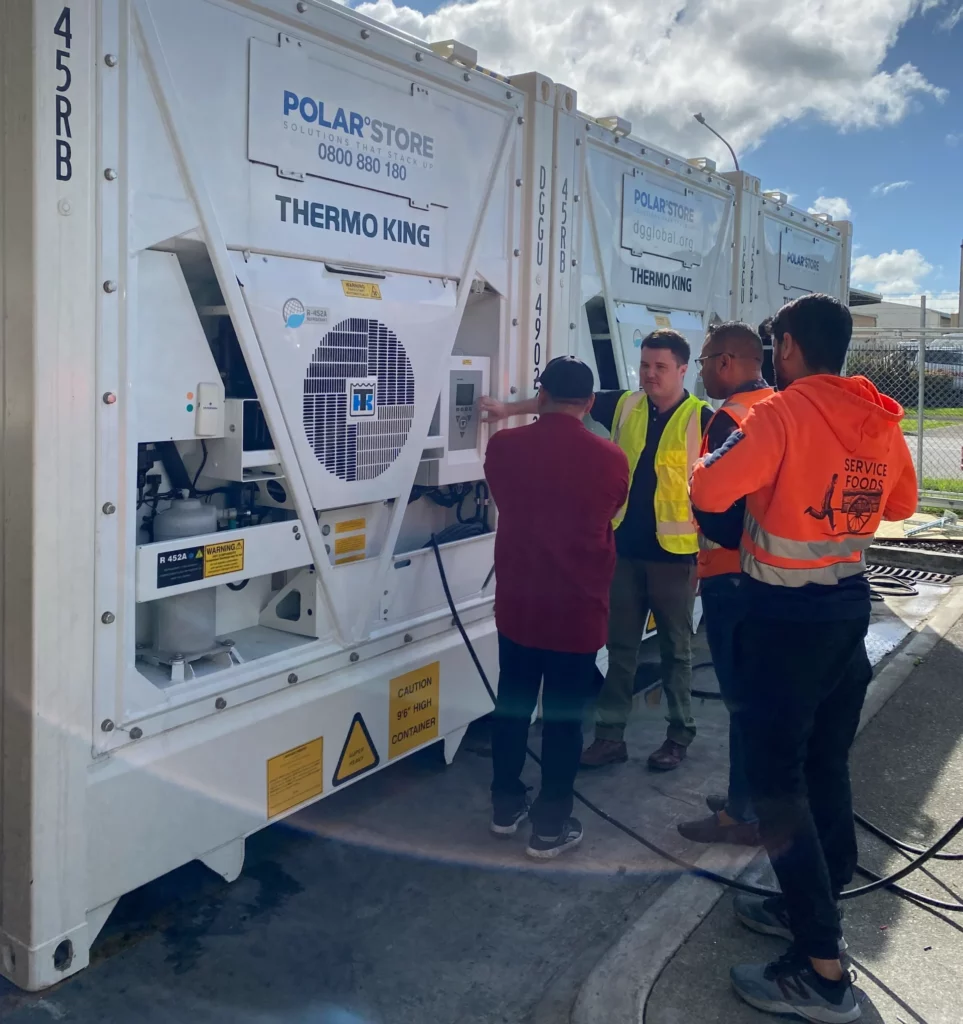Blast Freezer & Chiller Range
Specific Freezing & Thawing Solutions
DawsonGroup’s Blast Freezers and Chillers are available worldwide for hire or purchase. Our advanced units offer precise control over air circulation, enabling tailored blast freezing, chilling, and thawing for your products. With reversible cycles for precise thawing, we empower your business to meet its specific temperature needs.
Temperature, Size and Specs

Temperature Range
-70°C is achievable in 10ft and 20ft, 40ft can achieve +60°C

Dimensions
Available in 10ft, 20ft & 40ft sizes

Easy Access
Featuring easy-open double doors with a convenient 70/30 split for hassle-free entry.

Secure Design
Comes ready with an 18-metre cable, 5-pin plug, and 440v, 3-phase power supply, including earth and neutral connections.
| Container size | Operation range | Number of Refrigeration Machines | Model number | |
|---|---|---|---|---|
| 10ft (3m) HC | -40°C to +45°C | 1 | BF1096 | |
| Blast Freezer & Chiller | 20ft (6m) HC | -40°C to +45°C | 2 | BF2096 |
| 40ft (12m) HC | -40°C to +45°C | 5 | BF4096 |
Popular
Optional
Features

Remote Temperature Monitoring
Keep tabs on your cold storage remotely for peace of mind and precise control.

Internal Shelving
Improve organisation and efficiency by adding internal shelving to your cold room.

Support Legs for Dock Loading or Uneven Ground
Customise your cold room's placement with support legs for stability on any terrain.

Clip-On Generator Set for Intermittent Mains Power
Ensure uninterrupted operation with a clip-on generator set, perfect for situations with intermittent power supply.

Bespoke Customisations
Blast freezers, typically featuring a 70/30 entrance and single fridge layout, offer rapid freezing for perishable goods, but their utility can be further enhanced through customisations. Options for this include altering access points for single or multi-side entry and streamlining loading processes. Additionally, blast freezers can be optimised to meet pharmaceutical standards, ensuring compliance with GDP regulations.
Dual refrigeration systems provide reliability, minimising temperature fluctuations, and potential spoilage risks. Moreover, dual-temperature compartments allow simultaneous storage of goods at different temperatures, maximising storage capacity and flexibility. These customisations empower businesses to tailor blast freezers to their specific needs, improving workflow efficiency and product safety while maintaining regulatory compliance.
Frequently Asked Questions
Our Blast Freezers can reach as low as -70°C in 10ft and 20ft sizes, while the 40ft variant can achieve temperatures as high as +60°C, providing flexibility for various freezing and chilling requirements.
Our Blast Freezers and Chillers are available in three sizes: 10ft, 20ft, and 40ft, catering to different storage capacities and spatial constraints.
The units feature easy-open double doors with a convenient 70/30 split, ensuring hassle-free entry for efficient loading and unloading processes.
The Blast Freezer & Chiller units come ready with an 18-meter cable, 5-pin plug, and a 440v, 3-phase power supply, including earth and neutral connections, offering a convenient plug-and-play setup.
Reefer containers are used to transport a wide range of temperature-sensitive goods, including:
- Fruits and vegetables
- Meat
- Fish (both fresh and frozen)
- Milk and dairy products
- Flowers
- Pharmaceuticals
- Juice and concentrate
- Chocolate
Reefer containers are equipped with features to maintain the temperature, humidity, and atmosphere at constant levels throughout transit. Key features include:
- Temperature: Standard reefer containers can maintain temperatures between +25°C and -25°C for chilled and frozen cargo. Some units can go down to -35°C or even -70°C (super freezers).
- Ventilation: For chilled cargo, air must flow through the cargo to remove heat and gases, requiring ventilated transport boxes. Fresh air ventilation is essential for fruits and vegetables, while frozen goods need air circulation around the cargo without large gaps between the cargo and the container walls.
- Humidity: Reefer units can dehumidify the air, maintaining relative humidity (RH) levels typically between 60% and 85%, though some newer units can achieve 50%.
- Drains: Drains release excess water and prevent water or insects from entering the container.
Reefer containers need to be plugged into an electrical source, which can be located at a depot, terminal, onboard a vessel, or a genset.
Inside the container, a microprocessor serves as the electronic temperature recorder, storing data on supply and return air temperatures, remote cargo probe temperatures, defrost activity, setpoint changes, and power status. Cargo probes, equipped with temperature-sensitive elements, can record the cargo temperature of specific shipments. Dawson offers a portable data logger compatible with tracking and tracing systems, providing real-time temperature data of your goods.
No, a reefer container maintains a certain temperature but does not cool the cargo to the desired temperature. The cargo must be precooled to the set temperature before loading. For fresh fruits and vegetables, it’s crucial to reduce the temperature to optimal levels after harvest to ensure good quality and shelf life.
Non-operating reefers (NOR) are refrigerated containers used as dry boxes by deactivating the refrigeration unit during transit.
Using NOR containers allows for the redistribution of reefer containers from areas with a surplus to areas with a shortage. It also helps fill otherwise empty space on a ship, providing a price incentive due to the limited loading space in a reefer container compared to a dry container because of the refrigeration unit.
No, not all dry cargoes are suitable for transportation in a reefer container. The suitability depends on the specific requirements of the cargo.
Purchase/Hire A Reefer Container
Do You Have Other Questions?
Let's Work Together
Part of the Dawsongroup

